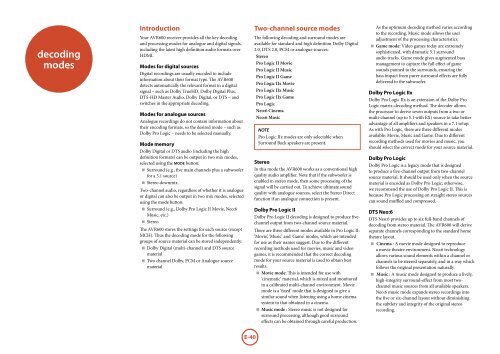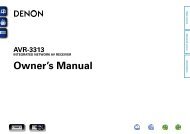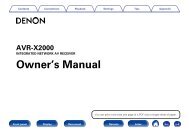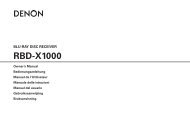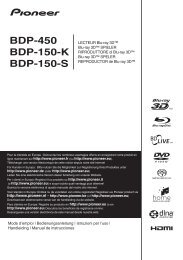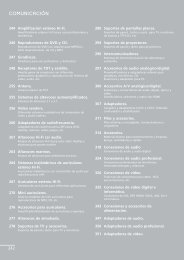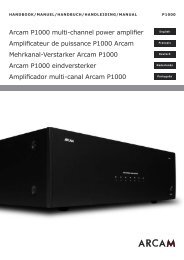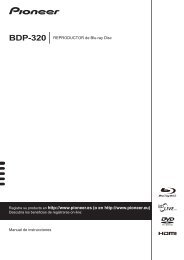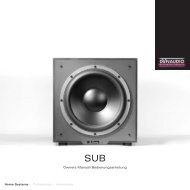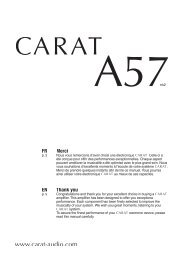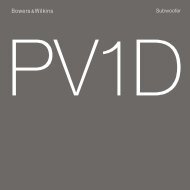You also want an ePaper? Increase the reach of your titles
YUMPU automatically turns print PDFs into web optimized ePapers that Google loves.
decoding<br />
modes<br />
Introduction<br />
Your <strong>AVR600</strong> receiver provides all the key decoding<br />
and processing modes for analogue and digital signals,<br />
including the latest high definition audio formats over<br />
HDMI.<br />
Modes for digital sources<br />
Digital recordings are usually encoded to include<br />
information about their format type. The <strong>AVR600</strong><br />
detects automatically the relevant format in a digital<br />
signal – such as Dolby TrueHD, Dolby Digital Plus,<br />
DTS-HD Master Audio, Dolby Digital, or DTS – and<br />
switches in the appropriate decoding.<br />
Modes for analogue sources<br />
Analogue recordings do not contain information about<br />
their encoding formats, so the desired mode – such as<br />
Dolby Pro Logic – needs to be selected manually.<br />
Mode memory<br />
Dolby Digital or DTS audio (including the high<br />
definition formats) can be output in two mix modes,<br />
selected using the mode button:<br />
< Surround (e.g., five main channels plus a subwoofer<br />
for a 5.1 source)<br />
< Stereo downmix.<br />
Two-channel audio, regardless of whether it is analogue<br />
or digital can also be output in two mix modes, selected<br />
using the mode button:<br />
< Surround (e.g., Dolby Pro Logic II Movie, Neo:6<br />
Music, etc.)<br />
< Stereo.<br />
The <strong>AVR600</strong> stores the settings for each source (except<br />
MCH). Thus the decoding mode for the following<br />
groups of source material can be stored independently:<br />
< Dolby Digital (multi-channel) and DTS source<br />
material<br />
< Two channel Dolby, PCM or Analogue source<br />
material<br />
Two-channel source modes<br />
The following decoding and surround modes are<br />
available for standard and high definition Dolby Digital<br />
2.0, DTS 2.0, PCM or analogue sources:<br />
Stereo<br />
Pro Logic II Movie<br />
Pro Logic II Music<br />
Pro Logic II Game<br />
Pro Logic IIx Movie<br />
Pro Logic IIx Music<br />
Pro Logic IIx Game<br />
Pro Logic<br />
Neo:6 Cinema<br />
Neo:6 Music<br />
NOTE<br />
Pro Logic IIx modes are only selectable when<br />
Surround Back speakers are present.<br />
Stereo<br />
In this mode the <strong>AVR600</strong> works as a conventional high<br />
quality audio amplifier. Note that if the subwoofer is<br />
enabled in stereo mode, then some processing of the<br />
signal will be carried out. To achieve ultimate sound<br />
quality with analogue sources, select the Stereo Direct<br />
function if an analogue connection is present.<br />
Dolby Pro Logic II<br />
Dolby Pro Logic II decoding is designed to produce fivechannel<br />
output from two-channel source material.<br />
There are three different modes available in Pro Logic II:<br />
‘Movie’, ‘Music’ and ‘Game’ modes, which are intended<br />
for use as their names suggest. Due to the different<br />
recording methods used for movies, music and video<br />
games, it is recommended that the correct decoding<br />
mode for your source material is used to obtain best<br />
results.<br />
< Movie mode: This is intended for use with<br />
‘cinematic’ material, which is mixed and monitored<br />
in a calibrated multi-channel environment. Movie<br />
mode is a ‘fixed’ mode that is designed to give a<br />
similar sound when listening using a home cinema<br />
system to that obtained in a cinema.<br />
< Music mode : Stereo music is not designed for<br />
surround processing, although good surround<br />
effects can be obtained through careful production.<br />
As the optimum decoding method varies according<br />
to the recording, Music mode allows the user<br />
adjustment of the processing characteristics.<br />
< Game mode: Video games today are extremely<br />
sophisticated, with dramatic 5.1 surround<br />
audio tracks. Game mode gives augmented bass<br />
management to capture the full effect of game<br />
sounds panned to the surrounds, ensuring the<br />
bass impact from purer surround effects are fully<br />
delivered to the subwoofer.<br />
Dolby Pro Logic IIx<br />
Dolby Pro Logic IIx is an extension of the Dolby Pro<br />
Logic matrix-decoding method. The decoder allows<br />
the processor to derive seven outputs from a two or<br />
multi-channel (up to 5.1 with EX) source to take better<br />
advantage of all amplifiers and speakers in a 7.1 setup.<br />
As with Pro Logic, there are three different modes<br />
available: Movie, Music and Game. Due to different<br />
recording methods used for movies and music, you<br />
should select the correct mode for your source material.<br />
Dolby Pro Logic<br />
Dolby Pro Logic is a legacy mode that is designed<br />
to produce a five-channel output from two-channel<br />
source material. It should be used only when the source<br />
material is encoded as Dolby Pro Logic; otherwise,<br />
we recommend the use of Dolby Pro Logic II. This is<br />
because Pro Logic processing on straight stereo sources<br />
can sound muffled and compressed.<br />
DTS Neo:6<br />
DTS Neo:6 provides up to six full-band channels of<br />
decoding from stereo material. The <strong>AVR600</strong> will derive<br />
separate channels corresponding to the standard home<br />
theatre layout.<br />
< Cinema : A movie mode designed to reproduce<br />
a movie theatre environment. Neo:6 technology<br />
allows various sound elements within a channel or<br />
channels to be steered separately, and in a way which<br />
follows the original presentation naturally.<br />
< Music : A music mode designed to produce a lively,<br />
high-integrity surround-effect from most twochannel<br />
music sources from all available speakers.<br />
Neo:6 music mode expands stereo recordings into<br />
the five or six-channel layout without diminishing<br />
the subtlety and integrity of the original stereo<br />
recording.<br />
E-40


